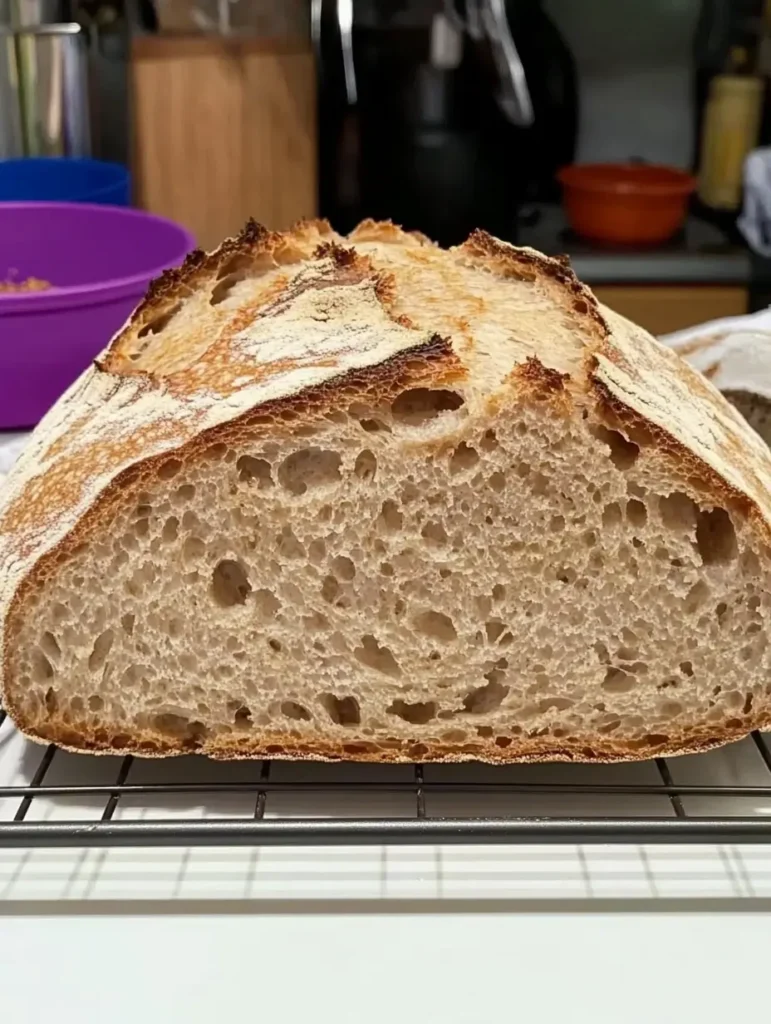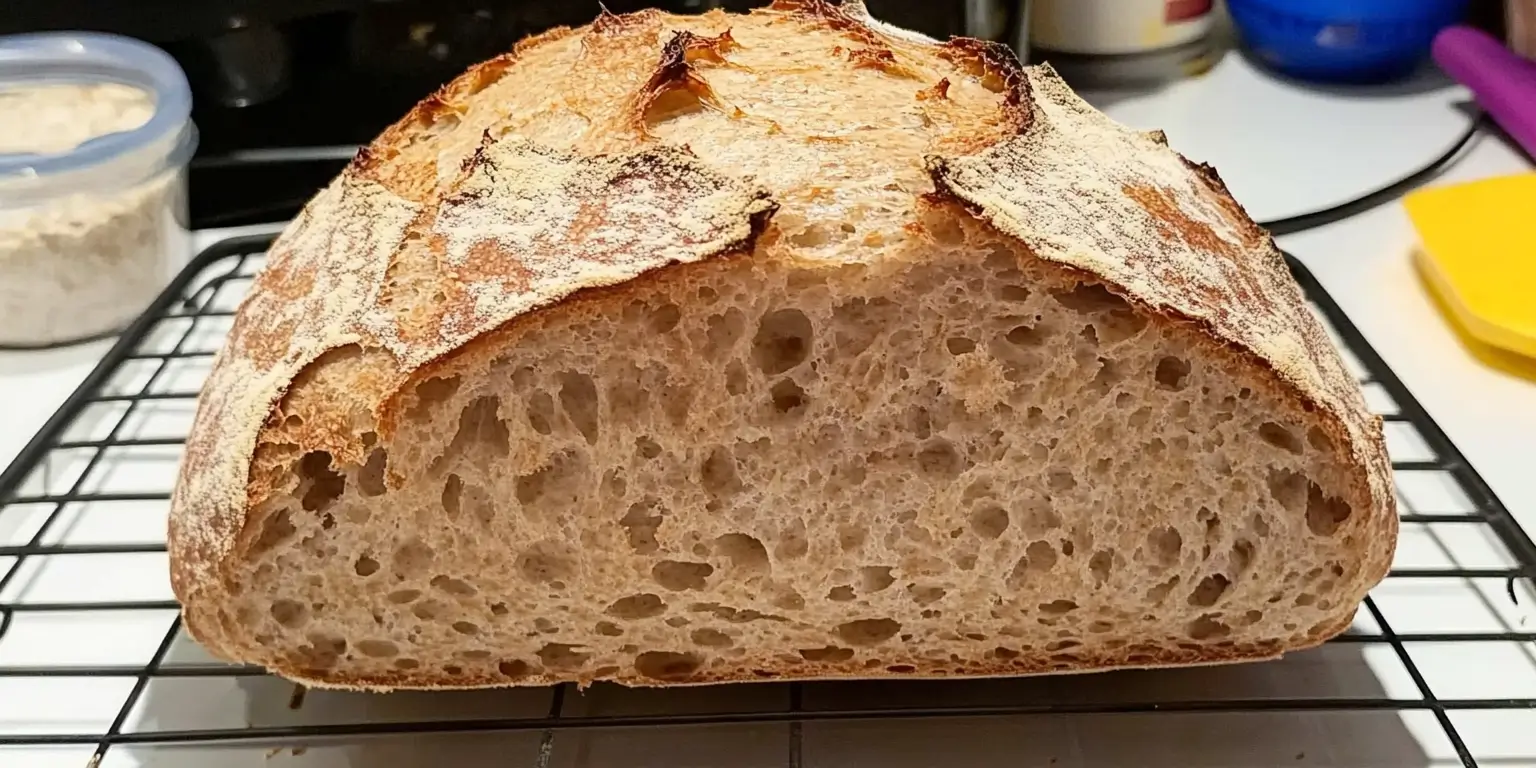I still remember the first time I pulled a loaf of gluten free sourdough bread from my oven. The golden crust crackled under my fingers, the scent was warm and tangy, and the steam that rose when I sliced it—pure magic. For years, I struggled to find a gluten free sourdough bread recipe that didn’t taste like cardboard or fall apart when I tried to toast it. I bought all the brands, tried all the tricks… nothing came close to what I was craving: a chewy, flavorful loaf that felt like home.
So I decided to make it myself.
If you’ve been searching for a slice of bread that makes you close your eyes and smile, you’re in the right place. This recipe is simple, nourishing, and truly the best I’ve ever had. Whether you’re gluten-sensitive or just curious, this bread will become your new favorite comfort food.
Ready to bake something that actually tastes like real bread? Let’s do this together.
💡 Why Choose Gluten-Free Sourdough Bread?
1. Better for Sensitive Tummies
If you’ve ever felt bloated after a sandwich, you’re not alone. A true gluten free sourdough bread recipe is easier to digest, thanks to natural fermentation. The sourdough process breaks down hard-to-digest carbs.
2. That Crusty Chew You’ve Been Craving
There’s nothing sadder than mushy gluten-free bread. This loaf has a golden crust and chewy inside that rivals the best bakeries.
3. You Know What’s in It
No preservatives. No weird gums. Just clean ingredients from your kitchen. If you’ve been wondering “does Subway have gluten free bread?” or “does Panera have gluten free bread?”, the answer is meh. This homemade loaf is so much better.
🥖 Ingredients You’ll Need for the Perfect Gluten-Free Sourdough Bread
- 1 cup active gluten-free sourdough starter
- 1 ¼ cup filtered water
- 1 ½ cup gluten free bread flour (blend of sorghum, rice, and buckwheat)
- 1 tbsp psyllium husk
- 1 tsp sea salt
- 1 tbsp olive oil
👩🍳 Step-by-Step: How to Make Gluten-Free Sourdough Bread
- Mix your dough with all ingredients.

- Let it rest for 30 minutes (hydration is key!).

- Stretch and fold 4 times, 15 mins apart.

- Bulk ferment for 8–12 hours overnight.

- Shape the dough and proof for 1–2 hours.

- Bake in a preheated Dutch oven—30 mins covered, 20 mins uncovered.

- Cool completely before slicing.

🌟 Tips for Success + Common Mistakes to Avoid
- Don’t skip the psyllium husk—it holds everything together.
- Don’t underbake. A gummy center is the #1 mistake.
- Store in a bread box or wrap in a towel—never plastic.
- Freeze slices with parchment between each for easy toast.
❓ FAQs About Gluten-Free Sourdough Bread
Is rye bread gluten free?
Nope. Rye contains gluten, even though it’s not wheat.
Is Ezekiel bread gluten free?
No, Ezekiel bread has sprouted grains that still contain gluten.
Can I use this recipe for sourdough sandwich bread?
Absolutely! Just bake in a loaf pan and adjust the time.
Can I make gluten free bread crumbs with this?
Yes! Toast and pulse in a food processor. Perfect for meatballs.
✨ Discover the Secrets to Make a Gluten-Free Sourdough Bread Recipe You’ll Never Forget
Discover the secrets to baking a comforting, golden loaf of gluten-free sourdough bread that’s chewy, crusty, and deeply satisfying—just like the real thing. These 10 tips will take your homemade loaf from good to unforgettable. Whether you’re brand new to baking or a seasoned sourdough lover looking for a gluten-free option, each of these insights is meant to guide you, inspire you, and help you bake with love and confidence. Don’t just follow a recipe—make it your own. 🥖💛
🧡 1. Fall in Love with Fermentation
The heart of sourdough lies in its slow, natural fermentation. This process doesn’t just help your dough rise—it breaks down starches and enhances digestibility. Your gluten free sourdough bread recipe will have a deeper, tangier flavor and a light, open crumb when it’s given time to rest and develop. Think of it like letting your bread breathe and bloom into its full potential. Give your dough the gift of time, and it’ll give you back something truly delicious.
🔥 2. The Crust Is Where the Magic Lives
There’s something so satisfying about cracking into a crust that sings. The secret? Bake your dough in a preheated Dutch oven at a high temperature with steam. This traps moisture, allowing the crust to set slowly and become that signature golden, blistered surface we all dream of. This is where your loaf gets that bakery-style texture. When done right, your gluten free sourdough bread crust will be crunchy outside but soft and airy inside—the perfect bite every time.
🫓 3. Unlock the Magic of a True Gluten-Free Sourdough Starter
The first time I made my own gluten free sourdough bread recipe, I was terrified of the starter. It felt like a science project gone wild. But trust me—once you get it going, it’s a total game changer. You’ll want to feed it like a pet (I named mine Doug the Dough 😄), and in return, it gives you the tangy, fermented flavor that makes sourdough so special.
👉 Tip: Use brown rice flour or gluten free bread flour for a solid start.
How to make a gluten-free sourdough starter
🍞 4. Choose the Right Gluten-Free Flours (It’s Everything!)
This part is so important, you guys. Your flour blend can make or break your loaf. I love using a mix of sorghum, buckwheat, tapioca, and a touch of gluten free bread flour. It’s all about balancing protein and starch.
Here’s a quick breakdown:
| Flour Type | Flavor & Texture |
|---|---|
| Sorghum | Mild, wheat-like, high in protein |
| Buckwheat | Earthy, dense, rich in fiber |
| Tapioca starch | Light, airy, helps with rise |
| Rice Flour | Neutral taste, helps with structure |
Experiment and find your perfect combo!
🔄 5. Mix, Knead, and Let the Dough Rest (Patience Pays Off)
Now it’s time to bring it all together. Mix your flours, starter, psyllium husk (a total lifesaver for texture), water, salt, and olive oil. The dough will feel sticky—don’t panic! That’s normal. Just give it time to rest and absorb.
- Mix everything gently.
- Let it sit for 30 mins.
- Then stretch and fold like you’re tucking a cozy blanket.
(This is the part I always look forward to!)
🔥 6. Fermenting: The Soul of Gluten-Free Sourdough Bread
Fermentation gives that sourdough zing. Place the dough in a bowl, cover it, and leave it overnight. If your kitchen is chilly, pop it in the oven with the light on (no heat!). In the morning, it should feel puffier and smell heavenly.
⏱ Ferment 8–12 hours for deep flavor.
💡 Fun Fact: Does sourdough bread have gluten? Traditional sourdough has less gluten, but not safe for celiacs. That’s why this sourdough bread gluten free version is so loved.
🍯 7. Baking: Your Kitchen Will Smell Like Heaven
This is your moment! Preheat your oven to 450°F with a Dutch oven inside. Score the top of your dough with a sharp knife or lame—this helps it rise beautifully.
- Bake covered for 30 minutes.
- Remove lid and bake another 20 minutes for that crusty magic.
- Cool completely before slicing (I know it’s hard!)
🧠 8. Psyllium Husk = Your Secret Weapon
Forget xanthan gum—psyllium husk is the MVP. It acts as a natural binder, giving gluten-free dough the elasticity it needs. Without it, your loaf might end up flat, crumbly, or too dense. Just a tablespoon of psyllium mixed with water turns into a gel that holds everything together beautifully. It mimics the stretchiness of gluten and gives structure to your sourdough, allowing it to rise and maintain that chewy, satisfying texture that makes it so special.
💪 9. Don’t Fear the Dough
Gluten-free dough doesn’t act like regular dough—and that’s okay. It’s often stickier, softer, and more delicate, especially before it ferments. But don’t let that scare you. Once you accept the unique feel of the dough, you’ll learn to trust it. Keep your hands lightly wet or oiled while shaping, and remember: rustic is beautiful. Every bump and crack tells the story of homemade love.
🍃 10. Choose Quality Flours
Not all gluten-free flours are created equal. Some are gritty. Some are bland. That’s why finding a good blend is key. Use high-quality options like sorghum, buckwheat, and gluten free bread flour mixes that are known for producing soft, delicious loaves. Always look for certified gluten-free labels to avoid any risk of cross-contamination. When your flours are fresh and thoughtfully chosen, the flavor and texture of your bread will absolutely shine.
💫 11. Be Patient with Proofing
The proofing stage is all about allowing your dough to develop character. If you rush this part, your loaf might end up dense or lack that sour flavor you crave. After shaping, give it another 1–2 hours to rest and rise again. Look for signs: the dough should feel slightly puffy and soft to the touch. You’re not just waiting for it to grow—you’re letting it mature into its best self.
🍴 12. Add-ins Make It Magical
Once you’ve nailed your base recipe, you can have so much fun customizing it. Add roasted garlic, chopped olives, herbs like rosemary or thyme, even sun-dried tomatoes. These add-ins give your sourdough bread gluten free style and flavor that feels gourmet. It’s like baking in your personality. Whether you’re going for savory or sweet, your loaf becomes a canvas for creativity.
💛 13. Toast It, Love It, Repeat
This bread isn’t just for slicing fresh. It toasts beautifully. The crust gets extra crisp, and the flavor becomes even more intense. Top it with butter, avocado, or a sprinkle of cinnamon sugar. Once toasted, it makes amazing gluten free bread crumbs too—perfect for breading chicken, topping casseroles, or making meatballs extra juicy.
🥙 14. Try Gluten-Free Pita Bread Too
If you fall in love with this recipe (and you will), give gluten free pita bread a try too! It’s fluffy, bendy, and perfect for stuffing with your favorite fillings. Plus, if you’re missing wraps or soft breads, pita gives you another delicious option to mix into your weekly meals. Bonus: it bakes quickly and pairs wonderfully with Mediterranean flavors.
🎉 15. Your Loaf, Your Legacy
There’s something deeply powerful about baking your own bread. It’s nourishment, connection, and tradition all in one. Whether you’re new to gluten-free living or a lifelong baker, this loaf is your way of creating something beautiful from simple ingredients. Share it with friends. Savor it with soup. Use it for your sourdough sandwich bread. But most of all—make it yours. Because the best bread isn’t just made with flour and water. It’s made with heart.
For more homemade cracker recipes, check out our Gluten-Free Pumpkin Bread or Gluten-Free Chocolate Cake!
If you enjoyed this recipe, we’d love to hear from you! Feel free to send us your thoughts or any questions you may have by visiting our Contact Us page.


4 thoughts on “The Best Gluten-Free Sourdough Bread Recipe You’ll Ever Try”